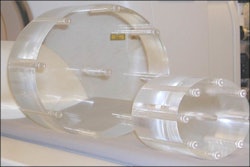
Removing comfort pads from underneath babies in the neonatal intensive care nursery prior to portable radiography exams could potentially reduce the radiation exposure the children receive, according to a study in the October edition of Academic Radiology.
 Lead author Dr. Amit Rattan from Indiana University.
Lead author Dr. Amit Rattan from Indiana University.
The team from Indiana University's Riley Hospital for Children found that the comfort pads can attenuate the radiation beam by as much as 72.1% depending on pad thickness. The findings prompted the hospital to institute a policy calling for removal of the pads for all but the sickest infants before radiography studies are performed.
"We have identified the comfort pads as a potential contributor to excess radiation exposure in the newborn intensive care nursery at our institution," the authors wrote (Acad Radiol, October 2013, Vol. 20:10, pp. 1297-1300).
Exposure indices
The discovery was made while investigating exposure indices, according to Dr. Mervyn Cohen, who co-authored the study with Dr. Amit Rattan. The exposure index concept was adopted several years ago by digital x-ray manufacturers to replace the mishmash of proprietary technical terms used up until then to measure the parameters that could contribute to a patient's radiation dose.
 Dr. Mervyn Cohen from Indiana University.
Dr. Mervyn Cohen from Indiana University.
Rattan and Cohen's team were investigating things that might attenuate the x-ray beam by coming between the beam and the digital detector when a radiologic technologist suggested they look into the comfort pads. Realizing the pads could be quite thick, Rattan and Cohen began a study to quantify the difference.
The researchers acquired a series of portable neonatal chest radiography exams with and without the pads using a phantom that simulates the thorax of a 1,500-g baby. They used pads with four different thickness levels: 0.5, 1, 3, and 8 inches.
Images were acquired with the facility's normal exposure factors for a 1,500-g baby, namely 66 kVp and 1.0 mAs, although images were also acquired at kVp settings of 56 and 76. The images were processed on a computed radiography reader (DX-S, Agfa HealthCare), and the exposure index was recorded for each exposure.
Rattan and Cohen found that exposure index decreased as the thickness of the comfort pad increased. Because the researchers were taking their measurements after the x-ray beam had passed through the patient, the drop indicated that radiation the infants had been exposed to was not being used in the formation of the image.
"The pad always lies behind the baby, and it attenuated x-rays that have already been through the baby," Cohen told AuntMinnie.com. "It's wasted radiation."
Exposure index reductions for selected combinations of pads are shown in the table below.
| Effect of comfort pad thickness on exposure index (EI) | |||
| Pad thickness | EI without pad | EI with pad | EI reduction with pad in place |
| 0.5 inches | 499 | 439 | 12% |
| 1 inch | 503 | 367 | 27% |
| 3 inches | 484 | 280 | 42.4% |
| 8 inches | 484 | 135 | 72.1% |
Cohen said that as soon as the data became available, he presented it to the manager of the hospital's neonatal intensive care unit, who agreed to implement a new policy calling for the removal of comfort pads from underneath babies receiving portable radiography exams. Nurses and doctors have the discretion of leaving the pads in place for very sick children, however.
"We've taken a common-sense approach that says, why give the baby radiation that's not going to contribute to image quality," Cohen said. "By taking the pad out, the image will be a little bit better with less noise than if we had the pad in."



















